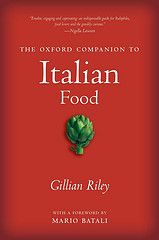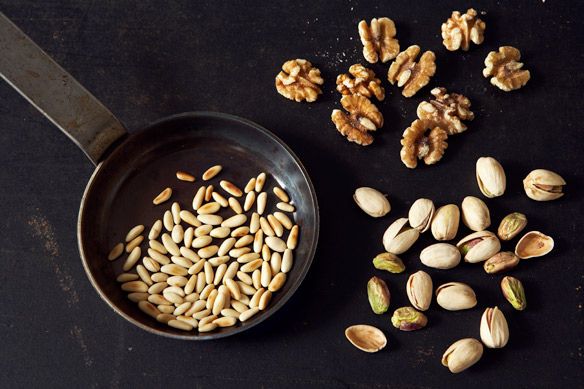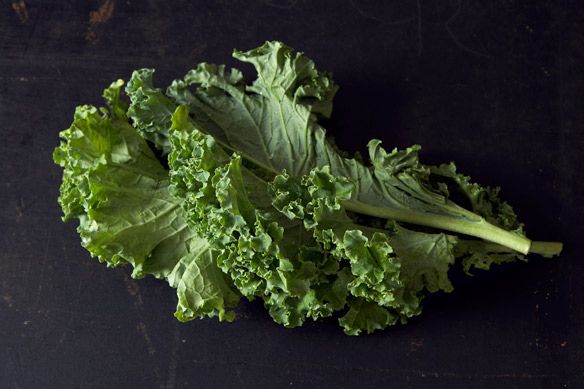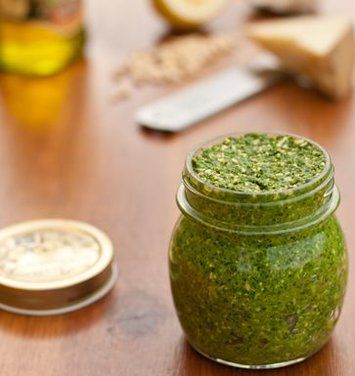Every other Thursday, we bring you Nicholas Day -- on cooking for children, and with children, and despite children. Also, occasionally, on top of.
Today: Nicholas wants us to make pesto like a 3-year-old -- with abandon, and especially with kale.

This is the season of pesto: there is no better time to make the sauce that almost all children, by some apparent secret agreement, are willing to eat. I have a reputation for insisting that your child will eat garlic. But there seems to be some sort of child-friendly alchemy when the raw garlic in pesto meets anything: it is all mysteriously okay.
But I am not here to give you yet another marginally altered, incrementally improved recipe for pesto genovese (basil, pine nuts, etc.). Basil, as Gillian Riley writes in The Oxford Companion to Italian Food, “is perhaps too well known as the main ingredient of pesto genovese.” And pesto, she adds, “has now become fossilised, in areas outside Italy, into an industrial product eaten almost exclusively with pasta.”

I want you to make pesto more randomly and more eccentrically. In short, I want you to make pesto more like a child would: with radical abandon followed by a lot of smashing. I do not know how Isaiah would make pesto, but I can tell you how he makes yogurt pops. His recipe, verbatim:
“I put some flour in a bowl. And I cook it for twenty one minutes. And then I add cinnamon and sugar. And some eggs. And then I cook it some more. And then I put it in the fridge. And then I have yogurt pops!”
I ask you, would Isaiah confine himself to basil and pine nuts and garlic? He would not! He would add—I dunno—finely crushed leaves! This would fix the fossilised recipe problem, although perhaps not in the way that Gillian Riley was envisioning.

Pesto will tolerate anything short of a garnish of autumn leaves. There are strictures—you do need an herb or vegetable, you do need oil—but they are not very strict. Add any nut you want (or none). Add garlic or not. Add cheese or not. Add almost any herb or green, alone or in combination. A pesto recipe is a Rorschach test for how you see the kitchen: you put in the things most prominent in your mind.
Hugh Fearnley-Whittingstall makes brown bread, hemp oil, and parsley pesto. Alice Waters makes traditional pesto with immaculate ingredients and she’d really prefer you used a mortar and pestle. Tamar Adler, who is incapable of looking at a compost pile without seeing dinner, makes pesto out of cores, stems, and leaves. (It’s the best broccoli-flavored butter ever made. But to a kid, it may look like the sort of green lump that adults are always trying to get you to eat. Isaiah gave his pile the look you’d give something that was walking across your plate.)
The point is that pesto knows no taxonomical boundaries: you should never have to go to the store because you’re missing an ingredient.

All of this brings us, inevitably, to kale, the “it” vegetable of the new century, the brassacia that ate Brooklyn, the only vegetable that inspires t-shirts. Earthy and ridiculously hale, with the sort of deep wrinkles you get from a life of soaking up the sun, kale has a sort of superfood emanence, especially to the parents of small children. Have you seen the internet lately? It is now mostly comprised of recipes for kale chips.
If you are skeptical, do not think of kale as bitter and earthy. Think of it as virtuous but tough, like a monk who kickboxes.
Kale pesto is not outlandish. Melissa Clark did it, cleverly pairing it with butternut squash—dessert meets dirt. Maria Teresa Jorge has posted a cavolo nero version. I riffed off ibbeachnana’s recipe, using less oil and toasting the walnuts (and just shocking the kale). We put it on pasta and added chunks of feta; some of us added chile flakes. It would be splendid on toast, on potatoes, with eggs. You lose the fragrance of pesto genovese, of course, but you gain a few notes on the bottom—it is a weightier thing.
And if you have some kale stems left over, you are most of the way to making stem pesto. Eat it after bedtime.

Kale Pesto by ibbeachnana
Makes 1 to 1 1/2 cups
1 big bunch of kale, rinsed, ribs removed and torn into large pieces
3/4 cups extra virgin olive oil (optional: 2 tablespoons of which Meyer lemon olive oil)
1/2 cup Parmigiano, microplaned
2 cloves garlic, smashed and roughly chopped
1/2 cup pine nuts
Salt and pepper to taste
1 tablespoon lemon juice, fresh
See the full recipe (and save and print it) here.
Photos by Joseph De Leo (except Kale Pesto, by Winnie Abramson)







See what other Food52 readers are saying.